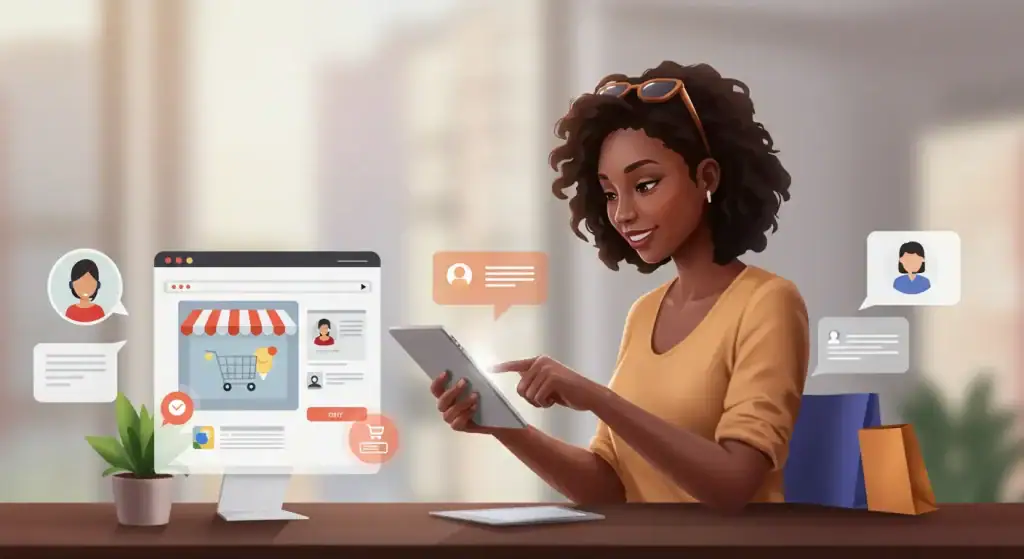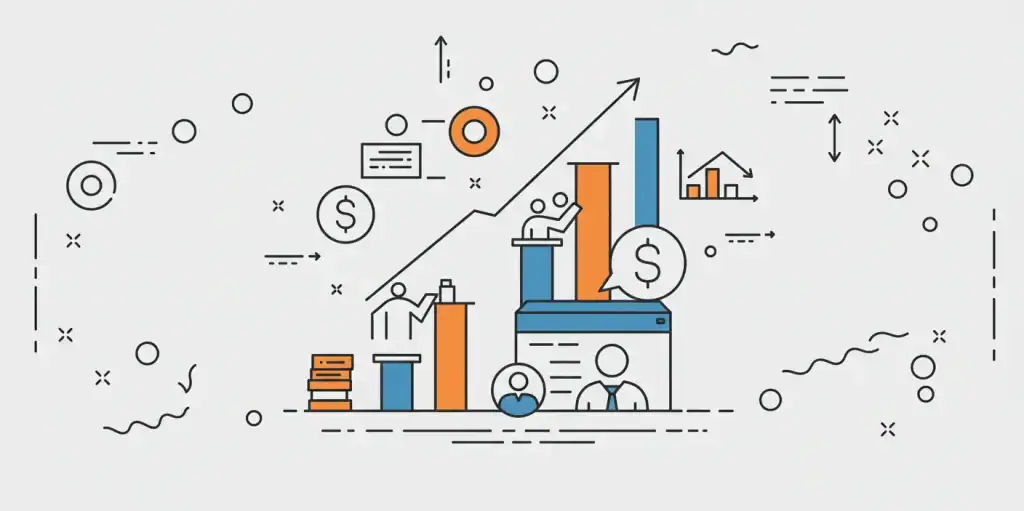The Business Growth Formula That Works in Any Economy
Finding consistent pathways to business growth can feel like searching for a needle in a haystack. Yet, certain fundamental principles remain effective regardless of economic conditions.
I've spent years working with struggling businesses that eventually flourished, and I've noticed patterns that separate those who merely survive from those who truly thrive.
Let me be clear – there's no magic bullet. But there are proven strategies that, when implemented correctly, dramatically increase your chances of sustainable business growth.
- Identify barriers to growth: strategic limitations, operational bottlenecks, and market engagement issues.
- Embrace a growth mindset by accepting calculated risks and learning from failures.
- Focus on the four pillars: value optimisation, customer acquisition, client experience, and performance metrics.
- Implement strategic partnerships and detailed market analysis for effective market expansion.
Breaking Down the Growth Barriers
Before diving into solutions, we must understand what holds most businesses back. Growth isn't just about working harder; it's about working smarter and addressing the right challenges.
Most business owners I meet are overwhelmed, understaffed, and without a clear roadmap. They're caught in the daily grind, fighting fires rather than building systems. Sound familiar?
The first step toward meaningful growth is identifying your specific barriers. These typically fall into three categories:
- Strategic limitations: Unclear vision, poor market positioning, or undefined unique value propositions
- Operational bottlenecks: Inefficient processes, inadequate systems, or resource constraints
- Market engagement issues: Weak customer acquisition, poor retention strategies, or ineffective marketing
Understanding which of these is your primary constraint will determine where to focus your initial growth efforts.
The Growth Mindset Shift
Business development begins in the mind. Many owners approach growth with deeply ingrained limiting beliefs about what's possible. They've tried things that didn't work, experienced setbacks, and developed a cautious approach that ultimately restricts potential.
I've witnessed this firsthand with clients who insisted their industry was “different” or that specific growth strategies “wouldn't work” for them. The businesses that break through these mental barriers are the ones that achieve exceptional results.
The shift requires:
- Embracing calculated risk is essential for growth
- Adopting an experimentation mindset where failures become learning opportunities
- Challenging industry norms rather than accepting them as limitations
This mindset shift must happen before any tactical approach will deliver meaningful results. A strategy executed with doubt and hesitation rarely succeeds.
The Four Pillars of Business Growth
After working with hundreds of businesses across various sectors, I've identified four fundamental areas that drive sustainable growth. These pillars form the foundation of what I call the Business Growth Formula.
Pillar 1: Value Optimisation

Growth begins with maximising the value you provide to your target market. This isn't just about product quality but the entire customer experience.
Value optimisation involves:
- Refining your core offer to solve your customers' problems more effectively
- Enhancing delivery mechanisms to reduce friction and improve outcomes
- Creating value hierarchies that allow customers to engage at different levels
A brilliant example of value optimisation comes from Inkbot Design's brand strategy service, which transformed how businesses approach their brand identity by focusing on strategic positioning rather than just visual elements.
Value optimisation requires continuous customer feedback loops. What delighted your customers last year might be their baseline expectation today. Markets evolve, and your value proposition must evolve with them.
Pillar 2: Customer Acquisition Systems
Without a reliable method for attracting new customers, business growth remains elusive. Yet many businesses approach customer acquisition haphazardly, jumping between tactics without developing coherent systems.
Effective customer acquisition systems:
- Target specific customer segments with tailored messaging
- Create clear, measurable conversion pathways
- Scale predictably with a consistent return on investment
Your acquisition strategy should incorporate multiple channels while focusing resources on those that deliver the best results. This doesn't mean chasing every new marketing trend, but developing expertise in channels that align with your customer behaviour.
Digital transformation has fundamentally changed customer acquisition across industries. Today's buyers research extensively before making contact, making your online presence and content strategy crucial to your growth formula.
Pillar 3: Client Experience and Retention

Acquiring new customers costs significantly more than retaining existing ones. Yet many businesses invest heavily in acquisitions while neglecting the experience that keeps customers returning.
Customer retention strategies should focus on the following:
- Exceeding expectations at key touchpoints in the customer journey
- Developing systematic check-ins and relationship-nurturing processes
- Creating natural pathways for expanded engagement over time
The businesses that excel at retention don't leave the customer experience to chance. They map every interaction, identify moments of truth, and design systems to ensure consistency. This approach transforms satisfied customers into passionate advocates who drive referrals and repeat business.
An outstanding approach to client experience can be seen in how Inkbot Design structures its customer journey, ensuring clients feel supported throughout the creative process.
Pillar 4: Performance Metrics and Financial Planning
You can't improve what you don't measure. Sustainable growth requires robust performance tracking and financial management systems.
The growth-oriented business maintains visibility on:
- Leading and lagging indicators for each department
- Cash flow projections with contingency planning
- Return on investment for all growth initiatives
Beyond tracking, this pillar involves creating accountability systems that drive consistent execution. The most brilliant strategy accomplishes nothing without implementation, and implementation falters without accountability.
Market Expansion Strategies That Work
With the four pillars established, let's examine specific strategies for expanding your market reach. These approaches have proven effective across various industries and economic conditions.
Strategic Partnerships and Ecosystems
One of the fastest paths to growth comes through strategic partnerships with complementary businesses. These relationships create win-win scenarios where both parties benefit from shared audiences and resources.
Effective partnership strategies include:
- Identifying businesses that serve your ideal customers but don't compete directly
- Creating joint offerings that provide enhanced value to both customer bases
- Developing systematic cross-promotion and referral systems
Many businesses overlook this approach, focusing instead on direct marketing that requires significantly more investment. Strategic partnerships allow you to leverage existing trust and relationships rather than building them from scratch.
The key lies in finding partners whose customers need your services and whose services your customers need. This alignment creates natural promotional opportunities that don't feel forced or transactional.
Target Market Analysis and Segmentation
Growth often comes not from reaching more people but from reaching the right people more effectively. Detailed market analysis lets you identify segments most likely to value your offerings.
Effective segmentation involves:
- Identifying behavioural and demographic patterns among your best customers
- Developing specific messaging and offers for each segment
- Allocating marketing resources based on segment value and acquisition cost
Too many businesses waste resources marketing to poor-fit prospects while neglecting high-potential segments. By focusing your efforts on customers who recognise and appreciate your value, you accelerate growth while reducing marketing costs.
Though the segmentation criteria may differ, this targeted approach applies equally to B2C and B2B contexts. The principle remains: specificity drives efficiency.
Revenue Growth Through Offer Architecture
Beyond finding new customers, substantial growth often comes from extracting more value from your existing customer base through thoughtful offer development.

Creating Your Value Ladder
A value ladder offers customers multiple ways to engage with your business at different price points and commitment levels. This approach allows you to serve customers throughout their journey while increasing lifetime value.
Components of an effective value ladder include:
- Low-barrier entry offers that allow customers to experience your value with minimal risk
- Core offerings that solve primary customer problems
- Premium experiences for customers seeking higher-touch solutions
- Continuity programs that create predictable recurring revenue
Each level of your value ladder should deliver a complete solution for a specific need while naturally leading to the next level for customers who want enhanced results.
Pricing Strategies for Profit Maximisation
Pricing is the most leveraged growth strategy available, yet many businesses approach it with fear rather than strategy. A 10% price increase typically has a more significant impact on profitability than a 10% increase in sales volume or a 10% reduction in costs.
Strategic pricing involves:
- Understanding the value perception of different customer segments
- Creating price anchoring through strategic offer comparison
- Developing premium options that increase the overall average transaction value
The most successful businesses don't compete on price—they compete on value. By clearly articulating your results and experience, you shift customer focus from cost to return on investment.
Operational Efficiency for Scalable Growth
Sustainable business growth requires systems that scale without proportional resource increases or management attention. This operational efficiency comes through process optimisation and strategic automation.
Business Automation That Makes Sense
Automation has transformed what's possible for businesses of all sizes. However, not all processes should be automated, and poorly implemented automation can damage customer relationships.
Effective automation strategy:
- Identifies repetitive, time-consuming tasks that don't require human judgment
- Implements systems that enhance rather than detract from the customer experience
- Creates capacity for team members to focus on high-value activities
The goal isn't to remove the human element entirely but to deploy technology that creates efficiency without sacrificing effectiveness. Customer-facing automation should feel helpful rather than obstructive.
Organisational Development for Growth Readiness
As businesses grow, organisational structures that work in earlier stages often become limitations. Preparing for growth requires developing systems and team capabilities to handle increased complexity.
Growth-ready organisations focus on:
- Documenting core processes to ensure consistency and transferability
- Developing team members through systematic training and coaching
- Creating clear accountability structures with appropriate autonomy
The transition from founder-centric to systems-centric operations represents a critical inflexion point for growing businesses. Those who navigate this shift successfully create the foundation for sustainable scaling.
Business Development Through Strategic Planning
Random tactics rarely produce consistent growth. Strategic planning provides the framework that ensures all growth activities align with your long-term vision and core advantages.

Competitive Advantage Analysis
Understanding your unique strengths relative to competitors lets you focus on areas where you can win consistently. This analysis goes beyond surface-level features to identify fundamental differentiators.
Practical competitive analysis examines:
- Core capabilities that are difficult for competitors to replicate
- Market positioning that creates a clear distinction in customer perception
- Resource allocation that reinforces strategic advantages
The goal isn't to compete in every area but to dominate in specific areas that matter most to your target customers. This focused approach allows even smaller businesses to outperform larger competitors in their chosen niches.
Brand Positioning for Market Leadership
Your brand position determines how customers perceive your business relative to alternatives. Strategic positioning creates mental real estate, making your business the obvious choice for specific needs or situations.
Effective brand positioning:
- Communicate who you serve and what problems you solve
- Establishes authority and credibility in specific domains
- Creates an emotional connection beyond functional benefits
Inkbot Design's branding expertise demonstrates how strategic positioning can transform how businesses are perceived in their markets, driving preference and premium pricing opportunities.
Customer Acquisition That Scales
Marketing approaches that worked at earlier stages often break down as businesses grow. Scaling customer acquisition requires systems that maintain effectiveness while increasing in scope.
Digital Marketing Strategies That Deliver Results
Digital channels have transformed customer acquisition, but the fundamental principles remain constant: reach the right people with the right message at the right time.
Effective digital strategies:
- Focus on channels where your ideal customers spend time
- Create content that addresses specific customer questions and concerns
- Develop attribution systems that track which efforts drive actual results
The most common mistake in digital marketing is spreading resources too thin across many channels. Mastery in one or two channels typically outperforms mediocre presence across many.
Lead Generation and Nurturing Systems
Not all prospects are ready to buy immediately. Systematic lead nurturing bridges the gap between initial awareness and purchase readiness.
Effective lead nurturing:
- Segments of prospects based on interests and behaviours
- Delivers value through educational content that builds trust
- Creates natural conversion opportunities as prospects become ready
These systems transform your marketing from a series of one-time campaigns into a continuous process that moves prospects through defined stages. This approach creates predictability in your customer acquisition efforts.
Cash Flow Management for Sustainable Growth

Growth requires investment, and investment requires cash. Poor cash flow management has killed countless promising businesses during growth phases.
Financial Planning for Expansion Phases
Growth often creates temporary cash constraints even as the business becomes more valuable. Planning for these constraints prevents unnecessary crises.
Effective financial planning for growth:
- Project cash requirements for each growth phase
- Identifies potential funding sources before they're needed
- Creates early warning systems for potential cash flow issues
The most successful growth strategies incorporate financial planning from the beginning rather than treating it as an afterthought. This integration ensures that growth initiatives remain financially sustainable.
Productivity Improvement Through Resource Allocation
Not all growth activities deliver equal returns. Strategic resource allocation ensures you invest time, money, and attention where they create the most significant impact.
Effective resource allocation:
- Identifies high-leverage activities with disproportionate returns
- Systematically eliminates or delegates low-value tasks
- Creates a focus on the completion of critical projects before starting new initiatives
This disciplined approach prevents the scattered efforts that characterise many growing businesses. By focusing resources on fewer, more critical initiatives, you accelerate results while reducing team burnout.
Business Innovation for Competitive Edge
Markets evolve constantly, and yesterday's competitive advantages eventually become today's table stakes. Ongoing innovation ensures your business maintains relevance and distinctiveness.
Product Development Strategies
Innovation doesn't always mean creating entirely new offerings. Often, it involves enhancing existing products or services to meet evolving customer needs better.
Effective product development:
- Maintains regular customer feedback loops to identify improvement opportunities
- Creates systematic testing processes for new features or offerings
- Balances innovation with maintaining excellence in core offerings
The most successful businesses create cultures where innovation becomes everyone's responsibility rather than being isolated in specific departments or roles.
Business Sustainability Through Adaptability
Long-term growth requires building adaptability into your business model. This adaptability allows you to navigate changing market conditions without fundamental disruption.
Building adaptive capacity involves:
- Developing scenario planning for different market conditions
- Creating flexible resource allocation systems
- Maintaining awareness of emerging trends and technologies
Businesses that thrive long-term aren't necessarily those with the best initial strategy but those most capable of evolving as conditions change.
FAQS About Business Growth
What's the biggest mistake businesses make when trying to grow?
The most common mistake is pursuing growth before establishing systems supporting it. This premature scaling leads to quality issues, team burnout, and customer disappointment. Build your operational foundation first, then accelerate.
How do I know which growth strategy is right for my business?
The right strategy depends on your current constraints. If you have more customers than you can handle, focus on operational efficiency and delivery systems. If you have capacity but few customers, prioritise marketing and sales systems. Identify your specific bottleneck and address it directly.
Is rapid growth always desirable?
Not necessarily. Sustainable growth that maintains quality and profitability is far more valuable than rapid growth that creates operational chaos. The pace should match your ability to maintain excellence throughout the growth process.
How important is company culture when scaling a business?
Culture becomes increasingly crucial as you grow. What happens informally in small teams must be systematised in larger organisations. Culture determines how decisions get made when you're not in the room, which becomes more frequent as you scale.
Should I focus on acquiring new customers or selling more to existing ones?
This isn't an either/or question. Both strategies matter, but many businesses overemphasise acquisition while neglecting the easier wins available through existing customer relationships. Start by maximising current customer value before investing heavily in acquisition.
How do economic downturns affect growth strategies?
Economic shifts change which strategies work best, but don't eliminate growth opportunities. Downturns often reduce competition and lower customer acquisition costs for businesses willing to invest counter-cyclically. They also force operational discipline that benefits the company in the long term.
What role does technology play in business growth?
Technology is an enabler rather than a solution itself. The right technology amplifies good strategies and systems, but won't fix fundamental business model issues. Invest in technology that addresses specific constraints rather than adopting new tools because they're trendy.
How do I balance growth with maintaining quality?
This balance comes through systematic quality controls that scale with your business. Document your quality standards, build verification systems, and create feedback loops that identify issues before they affect customers.
When should I consider outside funding for growth?
Funding makes sense when you have a proven model that delivers consistent returns and needs capital to scale. Before seeking financing, demonstrate how additional capital will create value and how that value will provide returns to investors.
What metrics should I track to measure growth effectively?
Beyond revenue, track leading indicators specific to your business model. These might include sales pipeline metrics, customer engagement measures, or operational efficiency indicators. The key is identifying metrics that predict future results rather than just measuring past performance.
Growing Your Business in Any Economic Climate
The business landscape will always have uncertainty, but the principles of sustainable growth remain surprisingly constant. By focusing on the four pillars we've discussed—value optimisation, customer acquisition, client experience, and performance metrics—you create a foundation that works regardless of external conditions.
Growth isn't about luck or timing but the systematic execution of proven principles. The businesses that thrive through changing conditions are those with clear value propositions, efficient operations, and the adaptability to evolve as markets shift.
If you're ready to implement these strategies in your business, request a quote from Inkbot Design to discuss how strategic design and branding can support your growth initiatives. Their team specialises in creating visual identities that communicate your unique value and position your business for sustainable growth.
Remember, business growth isn't just about getting bigger—it's about better delivering value to your chosen market. When you focus there, the growth will follow naturally.


